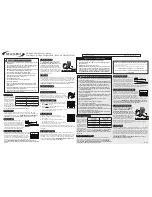
3
Extension Cords
CAUTION:
Use only extension cords that are approved by the country’s Electrical
Authority. Before using extension cords, inspect them for loose or exposed wires,
damaged insulation and defective fittings. Replace the cord if necessary.
Additional Safety Instructions
•
Hold tool by insulated gripping surfaces when performing an operation where
the tool may contact hidden wiring.
Contact with a “live” wire will also make
exposed metal parts of the tool “live” and shock the operator.
WARNING: ALWAYS
use safety glasses. Everyday eyeglasses are NOT safety
glasses. Also use face or dust mask if cutting operation is dusty. ALWAYS WEAR
CERTIFIED SAFETY EQUIPMENT:
• ANSI Z87.1 eye protection (CAN/CSA Z94.3),
• ANSI S12.6 (S3.19) hearing protection,
• NIOSH/OSHA/MSHA respiratory protection.
WARNING:
Some dust created by power sanding, sawing, grinding, drilling, and
other construction activities contains chemicals known to cause cancer, birth defects
or other reproductive harm. Some examples of these chemicals are:
• lead from lead-based paints,
• crystalline silica from bricks and cement and other masonry products, and
• arsenic and chromium from chemically-treated lumber (CCA).
Your risk from these exposures varies, depending on how often you do this type of
work. To reduce your exposure to these chemicals: work in a well ventilated area, and
work with approved safety equipment, such as those dust masks that are specially
designed to filter out microscopic particles.
•
Avoid prolonged contact with dust from power sanding, sawing, grinding,
drilling, and other construction activities. Wear protective clothing and wash
exposed areas with soap and water.
Allowing dust to get into your mouth, eyes,
or lay on the skin may promote absorption of harmful chemicals.
WARNING:
Use of this tool can generate and/or disburse dust, which may cause
serious and permanent respiratory or other injury. Always use NIOSH/OSHA approved
respiratory protection appropriate for the dust exposure. Direct particles away from
face and body.
WARNING: Always use eye protection.
All users and bystanders must wear eye
protection that conforms to ANSI Z87.1.
WARNING: ALWAYS wear proper personal hearing protection that conforms to
ANSI S12.6 (S3.19) during use.
Under some conditions and duration of use, noise
from this product may contribute to hearing loss.
CAUTION: When not in use, place tool on its side on a stable surface where it
will not cause a tripping or falling hazard.
Some tools with large battery packs will
stand upright on the battery pack but may be easily knocked over.
• The label on your tool may include the following symbols. The symbols and their
definitions are as follows:
V ................. volts
A ...............amperes
Hz ............... hertz
W ..............watts
min ............. minutes
...........alternating current
.......... direct current
no ..............no load speed
.............. Class I Construction
.............earthing terminal
...................
(grounded)
.............safety alert symbol
............... Class II Construction
…/min .......revolutions per minute
...................
(double insulated)
BPM ..........beats per minute
Important Safety Instructions for Battery Packs
Your tool uses a D
E
WALT battery pack. When ordering replacement battery packs,
be sure to include catalog number and voltage. Extended Run-Time battery packs
deliver more run-time than standard battery packs. Consult the chart at the end of this
manual for compatibility of chargers and battery packs.
NOTE:
Your tool will accept either standard or Extended Run Time battery packs.
However, be sure to select proper voltage. Batteries slowly lose their charge when
they are not on the charger, the best place to keep your battery is on the charger at all
times.
The battery pack is not fully charged out of the carton. Before using the battery pack
and charger, read the safety instructions below. Then follow charging procedures
outlined.
READ ALL INSTRUCTIONS


































